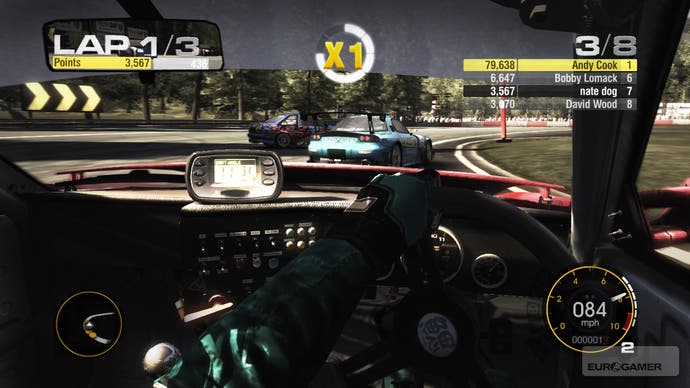Race Driver: GRID
Gentlemen, start your enthusiasm.
Pausing and restarting is such an integral part of games like PGR and GRID, where you want to begin every race perfectly, that it surely can't be long before someone binds it to a button, just as the time trial festishists who make TrackMania have done on the PC. But having perfected the start, what do you then do when you try and vault the chicane at 150mph on the last lap only to end up in a tyre wall? Traditionally, you shout and scream. In GRID's case, though, you just hit a button, rewind your mistake and try again.
Flashback is what they're calling it, and it does for GRID what the Sands of Time did for Prince of Persia in 2003: removes unnecessary repetition (and stops us throwing the control pad around the room). Like POP, Codies restricts Flashback's use, allowing you four of them on Normal difficulty. You can also wager your stock of Flashbacks to try and gain more reputation points - which unlock later challenges - by increasing the difficulty; whack it up and you earn more reputation points, but the pressure's on you not to screw up so much.
Not that this would count for anything if Flashback were awkward, complicated or slow to load, but it's none of these things. As soon as you start spinning out, you reach for the button, and after a short pause for a rewindy noise you're deposited on an instant replay screen watching the last few seconds of gameplay. The bumper buttons allow you to switch camera angles to judge when you'd like to retake control, at which point you hit the resume button, the game makes three flashbulb noises in quick succession, each accompanied by a still of the action from an arty angle, and you're back in the driving seat as if nothing went wrong. During 20 hours of play on the 360 retail copy provided for review, we only experienced a handful of split-second pauses at the flashbulb stage. Overall, it just works, and works without incident, and because it's tightly integrated and bound to difficulty level, it feels like a tool rather than a cheat. Flashback, then, is great. But what of GRID itself?
Like TOCA Race Drivers 2 and 3 before it, GRID is a collection of disparate racing sub-disciplines brought together in a single career mode. At the traditional end, there are races in Detroit muscle cars, professionally tuned Japanese sports-cars, open-wheel track cars from Formula 1000, and - lest we all forget where the series began - touring cars. But unlike 2 and 3, GRID builds on this not by veering into the esotericism of classic cars, ovals and rallycross, but into unknowns like Pro Touge and Drift Battles, and Demolition Derbies in the hunt for our love.

We're only too happy to oblige, as they're almost all great picks. Pro Touge, for instance, is a furious one-on-one race on tight Japanese mountain roads in slippery Japanese cars. You start marginally ahead of your rival and blast down the hill in the first phase, drifting around tight corners, and then start marginally behind him for the second, belting back up to the summit. Contact between cars is forbidden, with the second-place racer hit with a time penalty for any shunts, and the winner is determined by the cumulative gap in seconds between the two competitors. Pausing and restarting sends you all the way back to the top of the hill, so it demands concentration, and its sibling, Midnight Touge, is a one-way, no-holds-barred descent in the dark, and occasionally terrifying.








